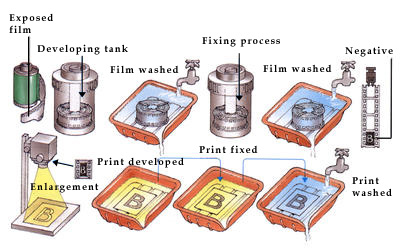|
|
 |
|
|
 |
|
How does film processing work?
|
Camera film is a plastic sheet coated with grains of silver salts that are sensitive to light. When film is exposed in a camera, the silver grains are affected by light. During processing, a developer converts the grains back to silver, forming a negative image. The negative is made into a positive print by projecting it onto a sheet of paper coated with similar silver salts. After development, light areas on the negative become dark areas on the print and dark areas become light. | | Film is developed to produce a negative, which is enlarged to make a print. |
|
| |
Previous:
Back
|
Book:
1001
|
Section:
Science and Technology
|
Chapter:
Chemistry
|
|
|
|
 |
|
|




